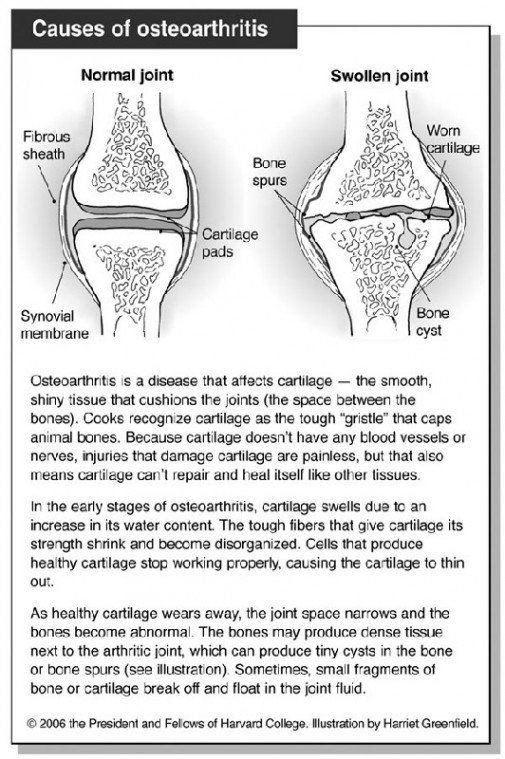Q: Are runners or other athletes who put extra stress on their
joints more likely to develop osteoarthritis than people who don’t
exercise?
By the Faculty of Harvard Medical School
Q: Are runners or other athletes who put extra stress on their joints more likely to develop osteoarthritis than people who don’t exercise?
A: Osteoarthritis (OA) is a disease that affects cartilage – the tough, slippery tissue that cushions the ends of our bones. Until recently, doctors blamed the stiff, swollen and painful joints that characterize this common disease on “wear and tear.” That theory – that simple overuse causes cartilage to break down – was logical but wrong. Time and mechanical stress do contribute to OA, but the process is really much more complex. In fact, scientists still don’t understand all the mechanisms involved.
But we do know more about the changes that occur in the joints (see illustration), as well as the many factors that can increase the likelihood of developing OA. They include:
– Age. Time takes a toll on the whole body, and joints are no exception. In fact, age is the strongest risk factor for OA. Although the disease can sometimes start in the 30s, it usually surfaces between the ages of 50 and 65, becoming more prevalent (and more prominent) with each passing year. Advancing age does mean more cumulative wear and tear, but age-related changes in the body’s metabolism, circulation and elastic tissue may be even more important.
– Heredity. OA tends to run in families. Heredity is particularly important in OA that strike at a young age (before age 50), in OA of the hands or hips, and in an uncommon form of the disease that strikes many joints at once.
– Obesity. This important risk factor is one of the few that you can actually correct. Extra weight makes joints work harder. For example, every 10 pounds of excess weight puts about 40 pounds of extra stress on the knee with each step. A study of young men suggested that each 18 pounds of extra weight increases the lifetime risk of painful knee OA by 70 percent.
– Mechanical abnormalities. Medical conditions that affect the nerves, muscles or bones, and that lead to faulty body mechanics (such as an abnormal gait) increase the stress on joints. The joints that bear the brunt of such stress are the most likely to develop OA.
– Injury. It’s the reason retired football players appear in advertisements for arthritis medication. A joint injury can seem to heal completely, but residual damage can progress slowly to produce OA later in life. A study of 1,321 Johns Hopkins Medical School graduates proves the point. Nearly 14 percent of doctors who suffered hip injuries during their student years developed hip OA by age 65, while only 6 percent of those without hip injuries developed OA. A knee injury in youth was even more significant, producing a fivefold increase in the risk of OA of the knee in maturity.
– Occupation and sports. Most nonrunners believe that running causes arthritis of the knees and hips, but most studies of runners say no. Repetitive use, such as long-distance running, has been linked to a slight increase in X-ray abnormalities, but not to an increase in the symptoms of OA (unless a significant injury has occurred along the way). Contrary to expectations, long-distance runners have fewer muscle and bone-related complaints over the years than sedentary folks. But occupations that involve frequent knee bending increase the risk of knee OA. And those that require frequent lifting appear linked to hip OA.
– Nutritional factors. Diet affects tissues throughout the body. The Framingham Knee Osteoarthritis Study linked low levels of vitamins C and D to an increased risk of OA. Unfortunately, there is no evidence that vitamin supplements can relieve the symptoms of OA or slow its progression. Still, a good diet is important for health, and weight control is particularly important for OA.
Submit questions to the Harvard Medical School Adviser at www.health.harvard.edu/adviser. Unfortunately, personal responses are not possible.














